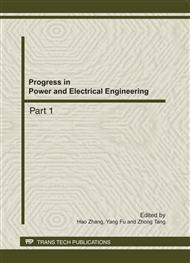p.890
p.896
p.901
p.906
p.913
p.918
p.922
p.927
p.931
Classification for Short Duration Disturbances Based on Row-by-Row Similarity of Generalized S-Transform Modulus Matrix
Abstract:
This paper proposes a power qulity disturbances classification method based on generalized S-Transform(GST) and maximum similarity principle. The GST gauss window changes self-adaptively with the main frequency of the power quality disturbances. The standard modular time-frequency matrixes are constructed by selecting special segment of GST modular matrixes of every category disturbance and scale-transforming based on bilinear interpolation. The test disturbances are dealed with same as the means of standard modular construction. Especially, for representing the difference of sags and swells, spikes and notches, etc., every row average of the standard modular time-frequency matrixes and the special frequency segment of the test disturbances are subtracted and then the similarity is computed. The simulation results verify the applicability and effectiveness of the proposed classification method.
Info:
Periodical:
Pages:
913-917
Citation:
Online since:
October 2011
Authors:
Price:
Сopyright:
© 2012 Trans Tech Publications Ltd. All Rights Reserved
Share:
Citation:


